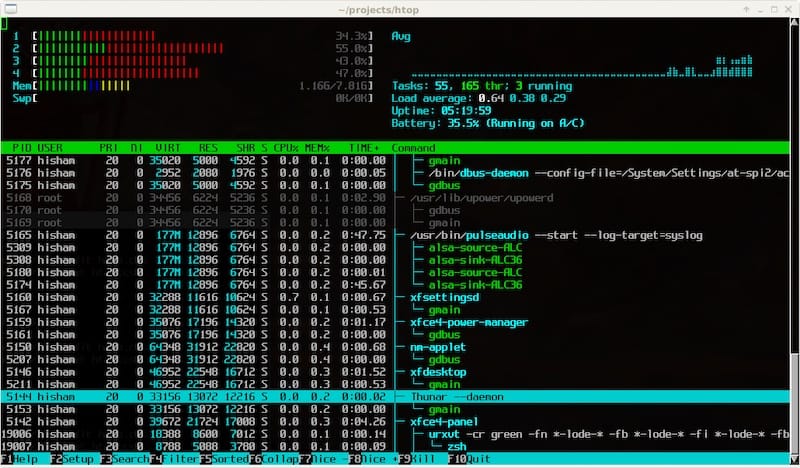How To Install Htop on Linux Mint 22

In this tutorial, we will show you how to install Htop on Linux Mint 22. When it comes to system monitoring and management on Linux, few tools are as versatile and user-friendly as Htop. This powerful command-line utility provides a real-time view of your system’s processes, resource usage, and overall performance. Htop is an enhanced version of the traditional top command, offering a more intuitive interface and a wealth of features that make it an essential tool for any Linux user or system administrator.
This article assumes you have at least basic knowledge of Linux, know how to use the shell, and most importantly, you host your site on your own VPS. The installation is quite simple and assumes you are running in the root account, if not you may need to add ‘sudo‘ to the commands to get root privileges. I will show you the step-by-step installation of the Htop interactive process viewer on Linux Mint 22.
Prerequisites
- A server running one of the following operating systems: Linux Mint 22.
- It’s recommended that you use a fresh OS install to prevent any potential issues.
- While we’ll guide you through the process, a basic understanding of the command line will be beneficial. If you’re new to the CLI, you might want to acquaint yourself with some fundamental commands.
- An active internet connection.
- Administrative privileges are essential for installing and configuring software on your system. Ensure that you have superuser or sudo access.
Install Htop on Linux Mint 22
Step 1. Update Your Linux Mint System.
Before installing any new software, it’s always a good practice to update your system’s existing packages to their latest versions. This ensures that you have access to the most recent bug fixes, security patches, and compatibility improvements. To update your system packages, open a terminal and run the following command:
sudo apt update sudo apt upgrade
This command will refresh the package list and upgrade any outdated packages to their latest versions. If prompted, enter your sudo password to authorize the operation.
Step 2. Installing Htop.
- Installing Htop via APT
The easiest and most straightforward method to install Htop on Linux Mint 22 is by using the Advanced Package Tool (APT). APT is the default package manager for Debian-based distributions, including Linux Mint. To install Htop using APT, run the following command in your terminal:
sudo apt install htop
APT will handle the installation process, automatically resolving any dependencies and configuring the necessary files. Once the installation is complete, you can verify that Htop is installed correctly by checking its version:
htop --version
If the installation was successful, you should see the version number of Htop displayed in the terminal.
- Installing Htop via Snap
An alternative method to install Htop on Linux Mint 22 is by using the Snap package manager. Snap is a universal package format that allows you to install and manage applications across different Linux distributions. To use Snap, you first need to ensure that it is installed and enabled on your system. Run the following commands to install Snap and enable its support:
sudo apt install snapd sudo systemctl enable --now snapd.socket
Once Snap is set up, you can install Htop using the following command:
sudo snap install htop
- Installing Htop from Source
For users who prefer to have more control over the installation process or require specific customizations, installing Htop from source is an option. This method involves downloading the source code, compiling it, and manually installing the resulting binaries. To get started, clone the Htop repository from GitHub:
git clone https://github.com/htop-dev/htop.git cd htop
Next, install the necessary dependencies for building Htop:
sudo apt install autotools-dev autoconf libncurses5-dev
With the dependencies in place, you can now build and install Htop:
./autogen.sh ./configure make sudo make install
After the installation is complete, you can verify the installed version of Htop:
htop --version
Step 3. Using Htop.
Now that you have Htop installed on your Linux Mint 22 system, let’s explore some of its basic usage and features. To launch Htop, simply open a terminal and run the following command:
htop
Htop will open in the terminal, presenting you with a real-time view of your system’s processes and resource usage.

Upon launching Htop, you’ll be greeted with a wealth of information about your system’s performance. The interface is divided into several key areas:
- CPU and memory usage bars: These bars provide a visual representation of your system’s CPU and memory utilization. Each CPU core is displayed separately, allowing you to monitor individual core usage.
- Process list: The main portion of the Htop interface is dedicated to displaying a list of running processes. Each process is shown with its process ID (PID), user, CPU usage, memory usage, and command.
- Load average and uptime: At the top of the Htop interface, you’ll find information about your system’s load average (the average number of processes running or waiting to run) and the system uptime.
Congratulations! You have successfully installed Htop. Thanks for using this tutorial to install the latest version of the Htop interactive process viewer on the Linux Mint system. For additional help or useful information, we recommend you check the official Htop website.